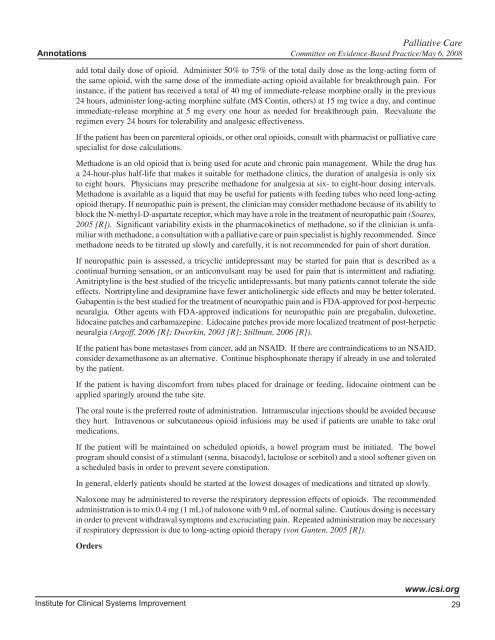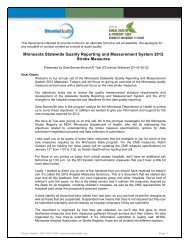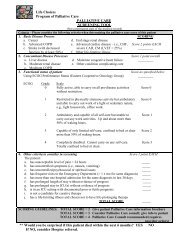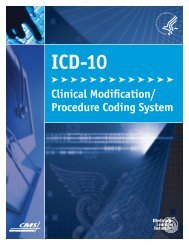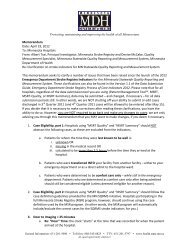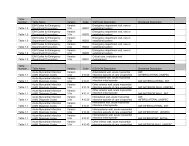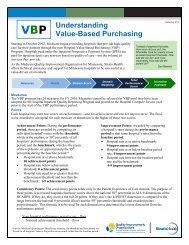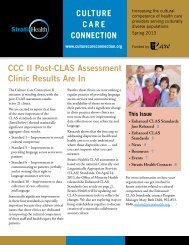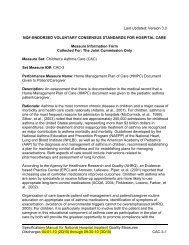Palliative Care Order Set - Stratis Health
Palliative Care Order Set - Stratis Health
Palliative Care Order Set - Stratis Health
Create successful ePaper yourself
Turn your PDF publications into a flip-book with our unique Google optimized e-Paper software.
<strong>Palliative</strong> <strong>Care</strong><br />
Annotations Committee on Evidence-Based Practice/May 6, 2008<br />
add total daily dose of opioid. Administer 50% to 75% of the total daily dose as the long-acting form of<br />
the same opioid, with the same dose of the immediate-acting opioid available for breakthrough pain. For<br />
instance, if the patient has received a total of 40 mg of immediate-release morphine orally in the previous<br />
24 hours, administer long-acting morphine sulfate (MS Contin, others) at 15 mg twice a day, and continue<br />
immediate-release morphine at 5 mg every one hour as needed for breakthrough pain. Reevaluate the<br />
regimen every 24 hours for tolerability and analgesic effectiveness.<br />
If the patient has been on parenteral opioids, or other oral opioids, consult with pharmacist or palliative care<br />
specialist for dose calculations.<br />
Methadone is an old opioid that is being used for acute and chronic pain management. While the drug has<br />
a 24-hour-plus half-life that makes it suitable for methadone clinics, the duration of analgesia is only six<br />
to eight hours. Physicians may prescribe methadone for analgesia at six- to eight-hour dosing intervals.<br />
Methadone is available as a liquid that may be useful for patients with feeding tubes who need long-acting<br />
opioid therapy. If neuropathic pain is present, the clinician may consider methadone because of its ability to<br />
block the N-methyl-D-aspartate receptor, which may have a role in the treatment of neuropathic pain (Soares,<br />
2005 [R]). Significant variability exists in the pharmacokinetics of methadone, so if the clinician is unfamiliar<br />
with methadone, a consultation with a palliative care or pain specialist is highly recommended. Since<br />
methadone needs to be titrated up slowly and carefully, it is not recommended for pain of short duration.<br />
If neuropathic pain is assessed, a tricyclic antidepressant may be started for pain that is described as a<br />
continual burning sensation, or an anticonvulsant may be used for pain that is intermittent and radiating.<br />
Amitriptyline is the best studied of the tricyclic antidepressants, but many patients cannot tolerate the side<br />
effects. Nortriptyline and desipramine have fewer anticholinergic side effects and may be better tolerated.<br />
Gabapentin is the best studied for the treatment of neuropathic pain and is FDA-approved for post-herpectic<br />
neuralgia. Other agents with FDA-approved indications for neuropathic pain are pregabalin, duloxetine,<br />
lidocaine patches and carbamazepine. Lidocaine patches provide more localized treatment of post-herpetic<br />
neuralgia (Argoff, 2006 [R]; Dworkin, 2003 [R]; Stillman, 2006 [R]).<br />
If the patient has bone metastases from cancer, add an NSAID. If there are contraindications to an NSAID,<br />
consider dexamethasone as an alternative. Continue bisphosphonate therapy if already in use and tolerated<br />
by the patient.<br />
If the patient is having discomfort from tubes placed for drainage or feeding, lidocaine ointment can be<br />
applied sparingly around the tube site.<br />
The oral route is the preferred route of administration. Intramuscular injections should be avoided because<br />
they hurt. Intravenous or subcutaneous opioid infusions may be used if patients are unable to take oral<br />
medications.<br />
If the patient will be maintained on scheduled opioids, a bowel program must be initiated. The bowel<br />
program should consist of a stimulant (senna, bisacodyl, lactulose or sorbitol) and a stool softener given on<br />
a scheduled basis in order to prevent severe constipation.<br />
In general, elderly patients should be started at the lowest dosages of medications and titrated up slowly.<br />
Naloxone may be administered to reverse the respiratory depression effects of opioids. The recommended<br />
administration is to mix 0.4 mg (1 mL) of naloxone with 9 mL of normal saline. Cautious dosing is necessary<br />
in order to prevent withdrawal symptoms and excruciating pain. Repeated administration may be necessary<br />
if respiratory depression is due to long-acting opioid therapy (von Gunten, 2005 [R]).<br />
<strong>Order</strong>s<br />
Institute for Clinical Systems Improvement<br />
www.icsi.org<br />
29


